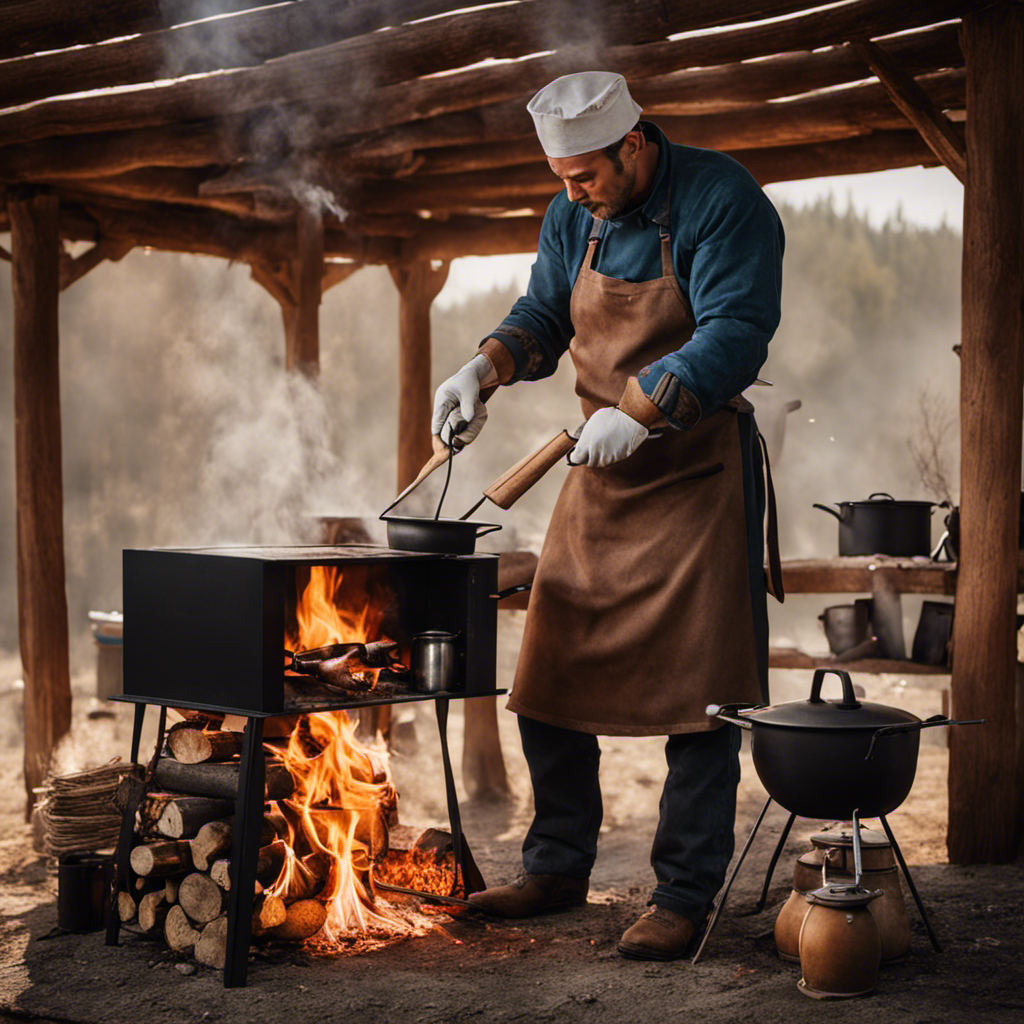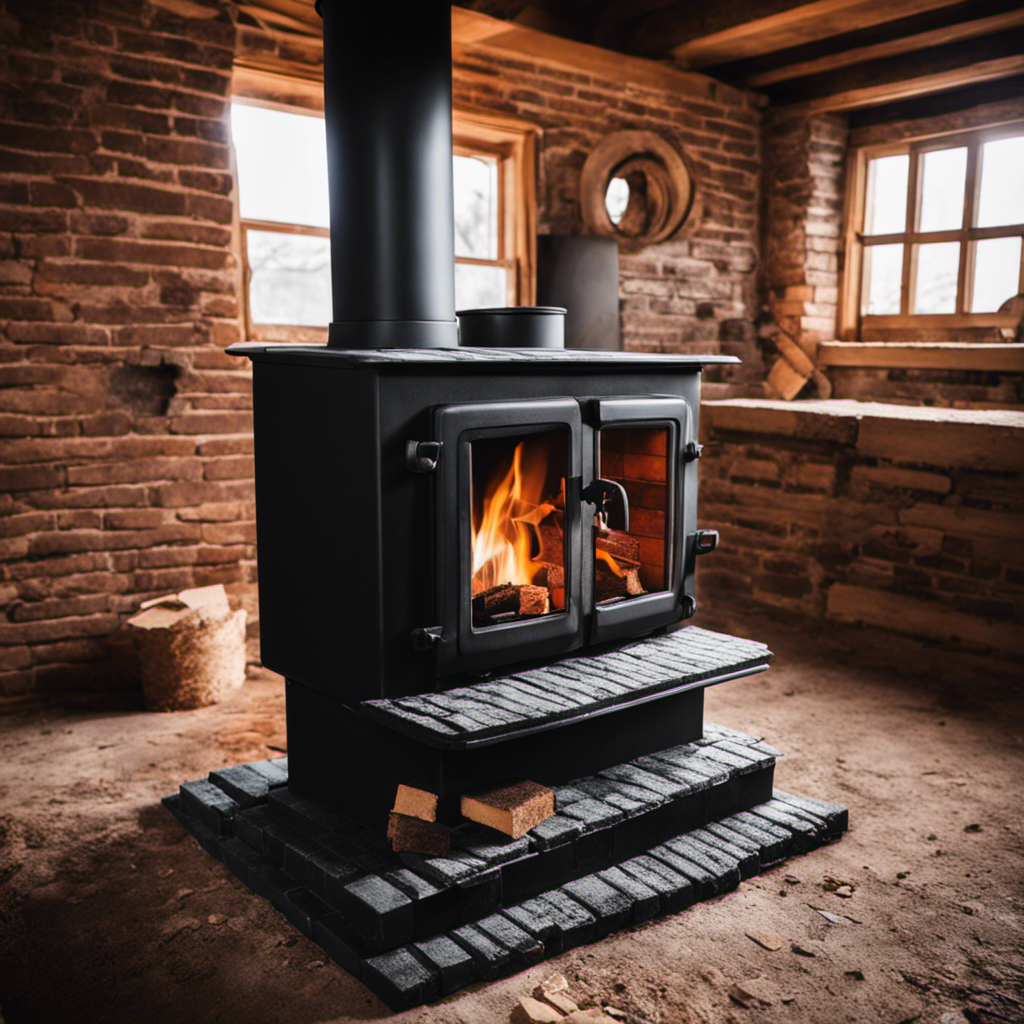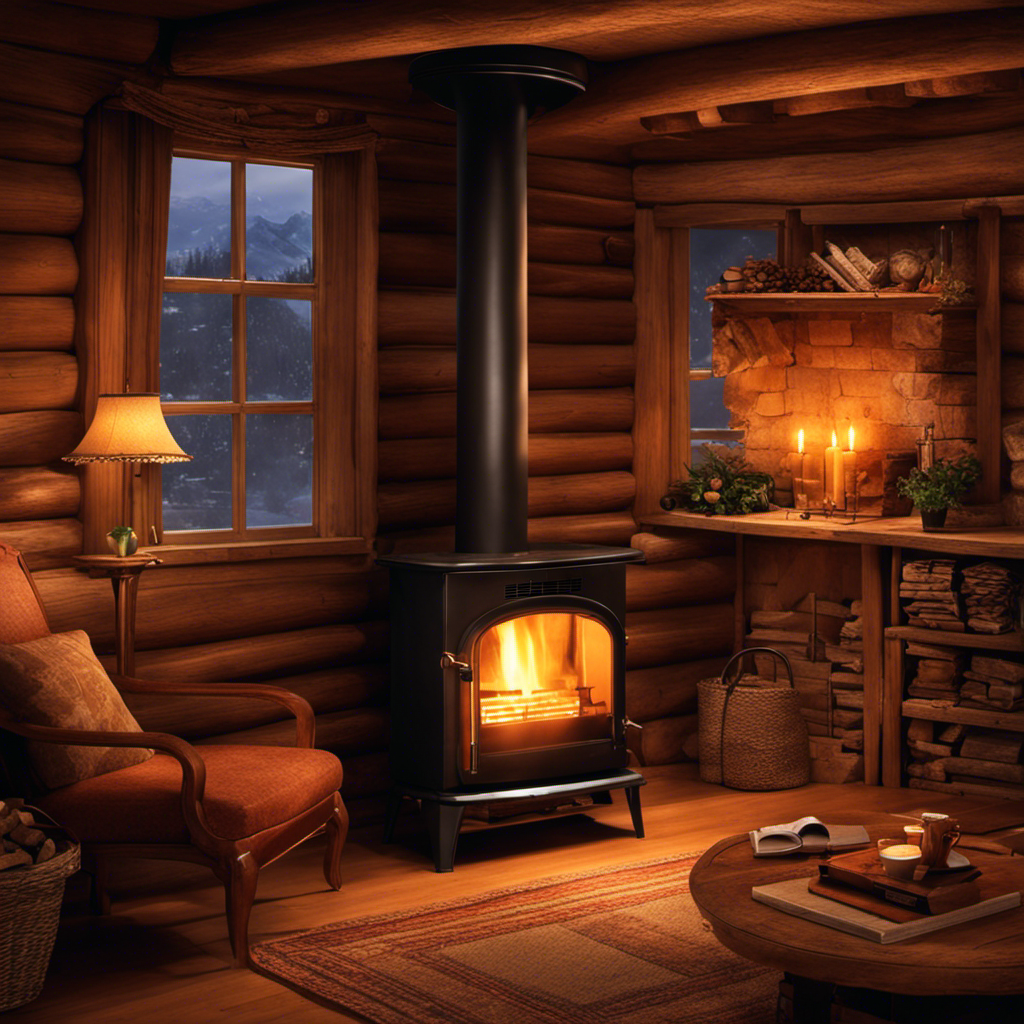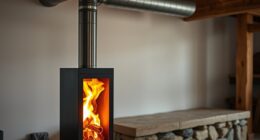The saying ‘Safety first’ is well-known to everyone, especially when it comes to using an outdoor wood stove. It’s crucial that we follow essential safety measures to not only safeguard ourselves, but also the people around us.
From having a fire extinguisher at hand to wearing protective clothing, each step plays a vital role in keeping us safe. In this article, we’ll explore the necessary precautions to take when using an outdoor wood stove for cooking.
Key Takeaways
- Keep a fire extinguisher nearby at all times.
- Regularly check and clean the stove to prevent malfunctions.
- Use fireproof materials like ceramic tiles or fire bricks.
- Ensure proper ventilation during the cool down period.
Importance of Having a Fire Extinguisher
We should always make sure to keep a fire extinguisher nearby when cooking with an outdoor wood stove. This is crucial for the safety of ourselves, our loved ones, and our surroundings.
The importance of regular stove maintenance can’t be overstated. Regularly checking and cleaning the stove ensures that it functions properly and reduces the risk of any malfunctions that could lead to fires.
Additionally, proper handling of hot ashes is essential. Always wait for the ashes to cool down completely before disposing of them. Use a metal container specifically designed for ash disposal, and never place it near flammable materials.
It’s also important to store the container outdoors, away from any structures. By following these safety measures, we can cook with peace of mind and ensure the well-being of everyone around us.
Using the Correct Fuel
Using the correct fuel is crucial when operating an outdoor wood stove. It ensures optimal performance and prevents potential hazards.
Proper Fuel Selection
We need to be mindful of the safety precautions when cooking with an outdoor wood stove, ensuring that we select and use the proper fuel for optimal performance.
One important factor to consider is firewood seasoning. It’s crucial to use properly seasoned firewood as fuel for your outdoor wood stove. Green or wet firewood can create excessive smoke and soot, which can be harmful to both the environment and your health. Seasoned firewood, on the other hand, burns more efficiently, producing less smoke and minimizing the risk of chimney fires.
Additionally, outdoor wood stove maintenance is essential to ensure safe and efficient operation. Regular cleaning of the stove, inspection of the flue, and removal of creosote buildup are crucial steps to prevent chimney fires and maintain optimal performance.
Fuel Storage Safety
To ensure fuel storage safety, it’s important that we store the correct fuel in a well-ventilated area away from any potential ignition sources. Fire prevention is crucial when it comes to handling fuels, as mishandling can lead to dangerous situations. Here are some essential safety measures to follow:
| Fuel Handling | Fire Prevention |
|---|---|
| Store fuel in | Keep flammable materials |
| approved containers | away from the storage area |
| and away from | Regularly inspect fuel |
| heat sources | containers for any leaks |
| or damage |
Fire Maintenance Tips
Our main focus when it comes to fire maintenance tips is ensuring the proper utilization of the correct fuel for optimum safety. It’s crucial to follow these tips to maintain a safe and efficient fire.
-
Proper firewood storage: Storing firewood in a dry and well-ventilated area is essential to prevent moisture build-up and ensure the wood burns efficiently.
-
Maintaining firewood moisture content: Wood with a moisture content of around 20% is ideal for burning. Using wood with higher moisture content can result in poor combustion and excess smoke.
-
Regular chimney and flue maintenance: Regularly inspecting and cleaning the chimney and flue helps prevent the build-up of creosote and reduces the risk of chimney fires.
-
Using appropriate fire starters: Avoid using flammable liquids to start the fire. Instead, use newspaper, kindling, or fire starters specifically designed for wood-burning fires.
-
Safe disposal of ashes: Always allow ashes to cool completely before disposing of them in a metal container. Properly store the container away from combustible materials.
Ensuring a Fireproof Surface
Have you considered how using a fireproof surface can enhance the safety of our outdoor wood stove cooking?
When it comes to cooking outdoors, having a fireproof surface is essential. Fireproof materials, such as ceramic tiles or fire bricks, can withstand high temperatures and prevent accidental fires. These materials act as a barrier between the wood stove and the ground, reducing the risk of sparks or embers igniting nearby flammable objects.
A fireproof cooking surface also provides stability for our pots and pans, ensuring that they remain secure while we prepare our meals. By investing in a fireproof surface, we can cook with peace of mind, knowing that we’ve taken an important step towards preventing accidents.
Now, let’s move on to the next safety measure: maintaining a clear area around the wood stove.
Maintaining a Clear Area
How can we ensure that we’re maintaining a clear area around the wood stove, and why is it important for our safety?
Ensuring a clear area around the wood stove is crucial for fire prevention and outdoor cooking safety. By maintaining a clear area, we reduce the risk of accidental fires and injuries. Here are some essential safety measures to follow:
- Keep flammable materials, such as curtains or paper, at a safe distance from the wood stove.
- Clear away any debris or clutter that could potentially catch fire.
- Install a fire-resistant barrier, such as a fireproof mat or tiles, around the stove to prevent heat transfer.
- Regularly clean the stove and chimney to avoid the buildup of flammable materials.
- Have a fire extinguisher nearby and make sure everyone knows how to use it.
Wearing Protective Clothing
Let’s make sure we’re wearing protective clothing to shield ourselves from potential burns while cooking with the outdoor wood stove. Safety should always be our top priority when it comes to any activity involving fire and heat. By taking the necessary precautions and wearing the right protective gear, we can minimize the risk of accidents and enjoy our cooking experience without worry.
Below is a table outlining the essential safety measures and the corresponding protective clothing to consider when cooking with an outdoor wood stove:
| Safety Precautions | Protective Gear |
|---|---|
| Avoid loose clothing or accessories that may catch fire | Wear fitted clothing and remove any jewelry or loose accessories |
| Use heat-resistant gloves when handling hot pots and pans | Invest in flame-resistant gloves to protect your hands |
| Wear closed-toe shoes to prevent burns from hot coals or embers | Opt for sturdy, closed-toe shoes or boots |
| Protect your eyes from sparks or flying debris | Wear safety goggles or glasses with side shields |
| Use an apron to shield your body from splatters and spills | Choose a fire-resistant apron to protect your clothing |
Staying a Safe Distance
When cooking with an outdoor wood stove, it’s crucial for us to stay a safe distance from the flames. This means maintaining proper firewood placement to prevent any unexpected flare-ups.
Additionally, using heat-resistant utensils allows us to handle hot pots and pans without putting ourselves at risk.
Maintaining Proper Firewood Placement
As we gather around the outdoor wood stove, we must ensure that we maintain proper firewood placement to stay a safe distance from the flames. It’s crucial to prioritize safety when cooking with an outdoor wood stove. Here are some essential measures to follow:
-
Keep firewood storage in a dry and ventilated area: Moisture content affects the efficiency of burning and can lead to excessive smoke or even chimney fires.
-
Season firewood properly: Allow firewood to dry for at least six months before using it in the wood stove. This ensures optimal heat output and reduces the risk of creosote buildup.
-
Place firewood away from the stove: Keep a safe distance of at least three feet between the stove and the stack of firewood to prevent accidental ignition.
-
Stack firewood securely: Stack firewood in a stable manner to prevent it from falling onto the stove or causing tripping hazards.
-
Regularly inspect the firewood: Check for signs of rot, mold, or insect infestation to ensure the firewood is safe to use.
Using Heat-Resistant Utensils
We should always use heat-resistant utensils and stay a safe distance from the flames when cooking with an outdoor wood stove. This is crucial to ensure our safety and prevent any accidents or injuries. Heat-resistant utensils are designed to withstand high temperatures and provide a barrier between our hands and the hot surfaces. Additionally, it’s important to wear heat-resistant gloves for added protection. These gloves are specifically designed to handle high temperatures and provide insulation for our hands.
By using heat-resistant utensils and wearing gloves, we can confidently cook with an outdoor wood stove without the fear of burns or injuries. It’s also important to avoid overcrowding the cooking area as it can increase the risk of accidents. By maintaining a safe distance from the flames and using the appropriate utensils and gloves, we can enjoy cooking with an outdoor wood stove safely and liberate ourselves in the kitchen.
To ensure proper ventilation, let’s discuss the importance of maintaining a clear airway for the stove.
Ensuring Proper Ventilation
To ensure proper ventilation, let’s open all the windows in the kitchen while using the outdoor wood stove. This is crucial for the safety and well-being of everyone in the area. Adequate airflow is essential to prevent the buildup of harmful gases, such as carbon monoxide, which can be produced during the combustion process.
To emphasize the importance of proper ventilation, consider the following measures:
- Install a vent hood above the stove to help remove smoke and odors.
- Use a carbon monoxide detector to alert you to any dangerous levels of gas.
- Ensure that the chimney or flue is clean and unobstructed.
- Regularly check and maintain the seals on doors and windows to prevent drafts.
- Consider installing additional ventilation systems, such as exhaust fans, if necessary.
Observing a Cool Down Period
How long should we wait before touching the stove after turning it off, and can we use this time to clean up any spills? When it comes to cool down precautions and ensuring post cooking safety, it is important to give the stove enough time to cool down before attempting to touch it or clean up any spills. The exact amount of time needed for the stove to cool down may vary depending on the type of stove and the intensity of the heat. However, as a general rule, it is recommended to wait at least 15-30 minutes before touching the stove and cleaning up any spills. This allows the stove to cool down sufficiently, reducing the risk of burns or accidents.
| Cool down precautions | Post cooking safety |
|---|---|
| Wait 15-30 minutes | Avoid touching hot surfaces |
| Use oven mitts or gloves | Clean up spills safely |
| Keep children away | Ensure proper ventilation |
Keeping Water Nearby
Having water nearby is essential for quickly extinguishing any potential fires that may occur while cooking with an outdoor wood stove. Fire safety should always be a top priority when using such stoves to prevent accidents. Here are five key reasons why having water nearby is crucial:
-
Immediate response: Water is the most effective and readily available tool to extinguish small fires that may start while cooking.
-
Rapid cooling: Water cools down the temperature of the fire, preventing it from spreading and causing further damage.
-
Neutralizes flames: Water disrupts the oxygen supply to the fire, smothering the flames and preventing them from growing.
-
Protection against burns: Splashing water on oneself or others can provide immediate relief in case of accidental contact with flames.
-
Peace of mind: Having water nearby allows for quick action, creating a sense of security and reducing the risk of accidents.
Frequently Asked Questions
How Do I Properly Clean and Maintain an Outdoor Wood Stove?
To properly clean and maintain an outdoor wood stove, we prioritize safety and ventilation. Regularly remove ashes and debris, clean the stove’s surfaces, and inspect the chimney for blockages. Ensuring proper airflow is essential for optimal performance and safety.
What Are the Potential Hazards of Using an Outdoor Wood Stove?
When cooking with an outdoor wood stove, it’s crucial to consider fire safety and the risk of carbon monoxide poisoning. Proper ventilation and the use of carbon monoxide detectors are essential for our safety.
Are There Any Specific Safety Precautions to Take When Cooking With Children Around?
When cooking with children around, it is important to prioritize cooking safety and child supervision. We must be knowledgeable, thorough, and detail-oriented to ensure their well-being. Let’s discuss the specific safety precautions to take.
Can I Use Any Type of Wood as Fuel for an Outdoor Wood Stove?
When using an outdoor wood stove, it’s important to consider the type of wood you use as fuel. Different woods have different burning properties and safety considerations. Follow best practices to ensure a safe and enjoyable cooking experience.
How Can I Ensure That My Outdoor Wood Stove Is Installed Correctly to Prevent Any Safety Risks?
To prevent safety risks, we ensure proper installation of outdoor wood stoves. This involves following manufacturer guidelines, ensuring proper ventilation and clearances, and regularly maintaining the stove for optimal performance.
Conclusion
In conclusion, when cooking with an outdoor wood stove, it’s crucial to prioritize safety measures. Ensure you have a fire extinguisher on hand and use the correct fuel to prevent any accidents.
Always cook on a fireproof surface and maintain a clear area around the stove. Wear protective clothing and keep a safe distance. Proper ventilation is essential, and it’s important to observe a cool down period before leaving the stove unattended.
Finally, keep water nearby in case of emergencies. Remember, better safe than sorry!
Logan’s affair with adventure began in childhood. He hailed from a small town where vast forests bordered one side and endless shores stretched on the other. His days were spent exploring uncharted woods, climbing tall trees, or listening to the tales of old sailors. This early immersion in a world brimming with stories and mysteries became the foundation of his passion for writing.











